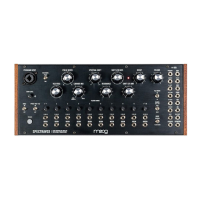18
U
S
E
A
D
Y
N
A
M
I
C
M
I
C
!
EXPLORING SPECTRAVOX (Continued)
Now, let’s explore Spectravox in VOCODER mode. Spectravox is not like contemporary vocoders—its
lineage comes from the analog filter banks of Moog modular systems, and as such requires a bit more
setup to get typical “vocoder” sounds. Even then, its sound is resonant and musical rather than precise
and analytical. While contemporary vocoders are designed for high-resolution vocoding, the semi-
modular nature of Spectravox makes it more of a playground to explore filter banks, formant tones,
and dynamic spectral processing.
By moving the MODE switch to VOCODER, the outputs of all 10 ENV F outputs
from the PROGRAM filter bank are patched internally to control the level of
the 10 bands of the synthesis filter bank (which shapes the CARRIER). If you’re
unsure about how vocoders work, take a look at the Understanding Vocoders
section of this manual to become better acquainted with some of the terms.
Don’t worry: as we go through the operation of Spectravox, these phrases
will become more clear. The most important thing is that you are able to use
Spectravox to create all the fun and interesting sounds you can imagine!
VOCODING WITH VOICE
Match your Spectravox to the settings diagramed above—an initialized vocoding patch. Connect a
microphone to the 1/4” / XLR combo jack PROGRAM INPUT—or use a recording of human speech if
you don’t have a microphone handy. Spectravox’s microphone preamplifier will work with un-powered
microphones like dynamic or piezo microphones. It does not supply phantom power and cannot power
condenser microphones or other microphones that require a bias voltage.
18
VOCODER

